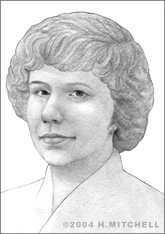Barbara Askins
The National Aeronautics and Space Administration, or NASA, was in its heyday when the organization established The Marshall Space Flight Center, named for General George C. Marshall, in 1960. In 1961, the Center, based in Huntsville, Alabama, sent Alan B. Shepard, the nation’s first official “astronaut”, on a sub-orbital flight and in 1969, helped send man to the moon.
The personnel that have been associated with the Marshall Center over the last several decades include some of the brightest, most innovative scientists in the world, including many outstanding women scientists. Chemist Barbara S. Askins was one of those scientists.
Born in 1939 in Belfast, Tennessee, Askins began her career as a teacher and became mother to two children. She waited until after they entered school to go back to college and complete her bachelor's degree in Chemistry. Askins continued with her education, completing her master’s degree in Chemistry, before she accepted a position as a chemist for the Marshall Space Flight Center in 1975.
At Marshall, Askins was asked to work on developing ways to improve the quality of photographic astronomical and geological images taken by researchers. Up until that time, the images taken from high above the earth were barely visible, though they contained a wealth of information.

In 1978, Askins came up with a way of enhancing the images using radioactive materials. The method she developed used radiology to help improve the quality of underexposed and otherwise useless negatives — after the film was developed. On July 18, 1978, Askins received U.S. patent No. 4,101,780 for a "Method of Obtaining Intensified Image from Developed Photographic Films and Plates." She was sole inventor on the project.
The process Askins developed was immensely successful, and before long, the technology was adapted for use in other NASA research as well as outside applications in X-ray technology and photo restoration. In 1979, the Association for Advancement of Inventions and Innovations named her the National Inventor of the Year. She was the first woman to be selected for this honor with sole title to the patent under consideration.
Askins was among the first American women to make significant contributions in the field of space exploration, working for NASA during an exciting time leading up to the launch of the first Space Shuttle in 1981. She and others at Marshall served as role models and mentors to the women entering the field in the 1980s and 1990s. Askins also contributed to several other important research projects and papers at Marshall during her tenure.


